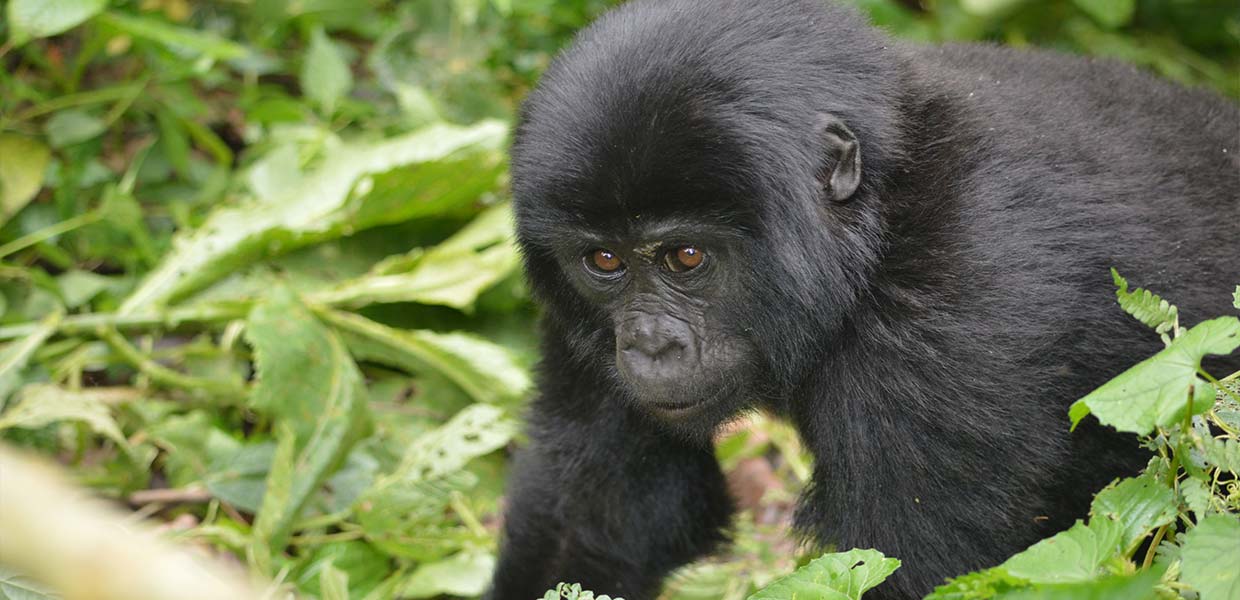Facts About gorillas, they are known to be massive, with a short, thick trunk and broad chest and shoulders. Its eyes and ears are dwarfed by its large head and a hairless, shiny black muzzle. Older males develop a crown of muscle and hair that makes the head look even longer. The arms are longer than the stubby legs. The fully adult male mountain gorilla is twice as large as the female.

Habitat
The most serious threat to gorillas is habitat loss. The rich volcanic soil of the Virunga is as highly valued as farming land. In Rwanda, Uganda, and Congo, a regional conservation program stressing the importance of maintaining the virgin forest watershed and the need to habituate some groups of gorillas for tourist visits has helped ease encroachment.
About Gorillas Behavior
The gorilla is shy and retiring rather than ferocious and treacherous. It usually seeks no trouble unless harassed but will valiantly defend its family group if threatened. Family groups are close-knit and may have up to 30 members, but even if smaller, the group usually consists of at least one older male, one or more females, and a few juveniles.
Gorillas have strong attachments to members of their group and even when groups meet and mingle and then subsequently part, each animal tends to remain with its respective unit. An adult male called a silverback named for the silvery grey hairs on its back normally leads each group, serving as its chief protector and defender. Gorillas continually wander through their home ranges of 10 to 15 square miles, feeding and resting throughout the day. Because gorillas are nomadic, they build new nests each day at dusk, constructing them of bent branches in a tree or grasses on the ground.
A group’s hierarchy, ritualized behaviour, and bluff charges between males prevent conflict among and between groups. Gorillas scream, grab foliage and stuff it in their mouths, stand erect on their hind legs, tear up and throw plants, drum on the chest with hands or fists, stamp their feet, strike the ground with the palms of their hands and gallop in a mock attack on all fours.
About Gorilla Diet
Animals of this size need a lot of food, and the vegetarian gorilla is no exception. Although they eat a variety of plants, favourites include wild celery, bamboo, thistles, stinging nettles, bedstraw, and certain fruit. These plants seem to provide sufficient moisture so that gorillas do not need water.
About Gorillas Caring for the Young
Mountain gorillas have a slow rate of reproduction. Females give birth for the first time at about age 10 and will have more offspring every three or four years. A male begins to breed between 12 and 15 years when he is in charge of his group. Able to conceive for only about three days each month, the female produces a single young.
Newborn gorillas are weak and tiny, weighing in at about 4 pounds. Their movements are as awkward as those of human infants, but their development is roughly twice as fast. At 3 or 4 months, the gorilla infant can sit upright and can stand with support soon after. It suckles regularly for about a year and is gradually weaned at about 31 / 2 years when it becomes more independent.
Predators
The gorilla’s only known enemies are leopards and humans. Crocodiles are potentially dangerous to lowland gorillas. In western Africa, gorillas are commonly hunted for meat or in retaliation for crop-raiding, but in eastern Africa, they have been the victims of snares and traps set for antelope and other animals. Poachers have also destroyed entire family groups in their attempts to capture infant gorillas for zoos, while others are killed to sell their heads and hands as trophies.

